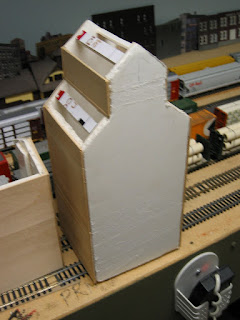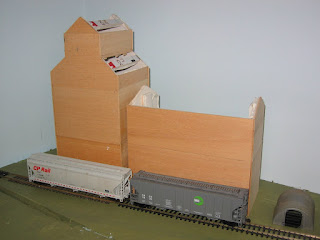
The UGG elevator at Turney, Manitoba.
Prairie giants . . . that's what the traditional wood crib elevators were called. Like giants, they were visible from a long ways away. To travellers, they were signs of civilization—wherever you saw a grain elevator, you knew there was a town. Even early aviators used them to help them navigate across the prairie provinces!
(Towns also ranked themselves by the number of elevators; if you came from a three-elevator town, you came from a big and important place.)
Since I am modelling the transition from the Canadian shield to the prairies, I needed grain elevators on the CP Rail Manitoba & Minnesota Subdivision. When I started building the layout, the only commercial kits available were much too small, so I decided to build my own.
As has been said on this blog many times before, I'm no expert craftsman or perfect modeller; my models will never win any contests. As with everything else I do on the layout, I strive for "good enough." Does it look like a prairie elevator? If yes, then it's good enough for me.
The method I like best for making elevators is to build a subframe out of foamcore, then glue on wood siding. (You could use styrene, too.) The trick is to make them big enough to be plausible—in real life, they are really tall—but not so tall as to dominate the scene.
The shingles are made from file cards, cut in strips and then cut to represent shingles.
The photos below show some of the construction process.

The elevator from the back, showing the
foamcore and the roof bracing. No back is
needed since it abuts the backdrop.

The annex from the front.

The annex from the back. No back is needed since
it abuts the backdrop.

The elevator from the front.

Before the roofs and scenery are added.

Another view of the elevator, with The Canadian
passing in the foreground.

Another elevator built using a similar
method, this one at Nance, MN.
Nice job.
ReplyDeleteWhat type of glue did you use?
ReplyDeleteContact cement.
ReplyDelete